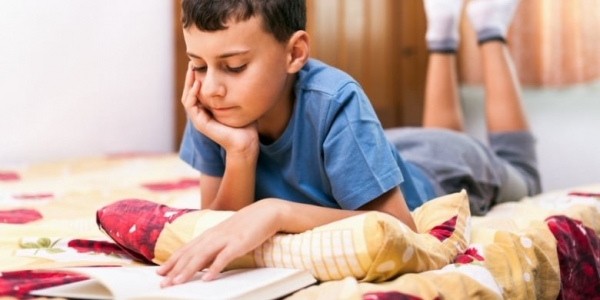Around the nation, K–12 schools are frantically trying to adapt to abrupt closures during the coronavirus. But while all teachers are struggling with the new normal, special education teachers, in particular, are facing unparalleled challenges transitioning both their teaching—and their students and families—to home-based instruction tailored to each student’s needs.
“When you say ‘special education,’ you are talking about an umbrella of ages, interests, abilities, and disabilities, within which are individual needs identified by their Individualized Education Program,” explains Margaret Shafer, a third-grade teacher in Morton, Illinois, echoing questions raised by our readers, who wonder how they can provide sufficient support for each of their students who each have very different requirements to learn.
Unlike developing a whole-class lesson plan online, special education teachers are now tasked with developing unique plans for every student that align with their IEPs, as required by federal mandate. One huge hurdle, teachers say, is determining if both the learning and services students are accustomed to receiving in school—things like gross motor remediation and behavioural therapy—can even be offered in a home-based setting or through digital resources.
Both special education and general education teachers have also questioned how much parents and caregivers will be able to help, given that students with special needs often rely on specialized coaching and instruction like cues or sensory activities that keep them on task. “[My students] are non-verbal and need one-on-one direct instruction with multiple prompts or redirection,” explained Beth McGreevy Dworak on Facebook. “Many have attention and behaviour deficits and are unable to independently complete most tasks.”
Additionally, many students with special needs thrive within the structure of the school day, say educators in our audience, who worry students may be disproportionately impacted by the upheaval brought on by the coronavirus.
But though the new reality is a sudden and upsetting shift, special education educators already have some ideas on how to make the best of it.
SETTING UP HOME-BASED LEARNING
While time is of the essence, special education educators recommend working on establishing an appropriate learning environment and objectives for students and their families before launching into a detailed list of to-dos and daily activities.
What’s it like at home? Phone calls to families early on can give teachers a sense of each students’ home set-up. Teachers can ask questions like Will parents be home all day? Will they be working while at home? Is internet available? What electronic devices can students use? Is there space in the home to set aside for gross motor or sensory activities? Teachers can then map individualized plans to the available resources.
“The teacher’s work transforms from a direct learning model to a coaching model: The teacher now supports the families through the process of understanding school expectations and goals and objectives,” said Patti Sullivan-Kowalski, a senior director of student supports and special education in Meriden, Connecticut.
Recalibrate goals and objectives: After understanding each student’s circumstances, Kathryn Fishman-Weaver, director of academic affairs and engagement for Mizzou Academy, suggests that teachers evaluate which IEP goals are achievable in the new environment, and then work with families to break learning targets into manageable benchmarks.
According to federal regulations, schools have greater flexibility in meeting IEP objectives during the pandemic and should work to the best of their ability to provide what services they can—even if they are digital—recognizing these services may not be the same as what a student receives in school.
Proactively engage (but be flexible): Parents are also likely to need continuous guidance, say, educators, who advise checking in regularly with families via phone, video conference, or email to make sure they feel supported. For parents and caregivers whose first language is not English, educators encourage translation services like a three-way interpreter to ensure sufficient communication. The Meriden school district created a Google classroom group just for parents of children with special needs so they can connect to each other and swap ideas about what’s working well (and what’s not) at home.
Kathryn Nieves Licwinko, a special education teacher in Sparta, New Jersey, says teachers should try to be more flexible about their own hours, and make themselves available via different modes of communication to adjust to differing family circumstances.
“Many students have parents still working who are not home with them, so it becomes more difficult for them to complete assignments,” she said. “I have students who haven’t come into contact with me for a week now because they haven’t been able to get onto their device and their parents aren’t home to help.”
STUDENT GOALS AND LEARNING
Upending a regular routine can be especially upsetting for students with special needs, our audience asserted—so teachers and families should work together to create home learning activities that resemble the school day.
Emphasize structure: “Most of my students thrive under structure and routine. They benefit from having teaching staff available for constant instruction, clarification, and focus,” said Eric Fieldman, a high school special education teacher in Collingswood, New Jersey. “Being at home, even with the same level of academic work, lacks the same focus and can lead to inconsistent work effort.”
Fieldman and other teachers recommend creating a daily list of activities—broken into small chunks with plenty of breaks—that, if possible, follow a similar order to the schedule students had at school. Because many students with special needs respond well to visual cues, a schedule board (tactile or digital) with images of activities that prompt students what to do when can be helpful, teachers said. Fieldman also recommends using a kitchen timer, which reminds students of a bell schedule at school.
Dan Vollrath, a high school special education teacher in Flemington, New Jersey, adds that parents may even want to try having learning activities take place in different spaces or rooms in a home, as students are used to shifting locations at school depending on what they’re learning.
Communicate with parents and caregivers clearly: While teachers are likely to create instructional videos (or written directions) for students, our special education educators also advise creating them for parents to teach them how to set up and support their children in various activities. Some video services offer translations for parents whose first language is not English. Teachers can also think of ways parents can use generic objects in the home to teach skills, like Cheerios, toothpicks, or pennies, which can be repurposed as math manipulatives.
Still, parents and teachers shouldn’t feel everything from school can or even should be replicated. “There is not a perfect parent out there who can manufacture a full ‘school experience’ given the school, time, and resource limitations,” said Sarah Kesty, a middle school special education teacher in Chula Vista, California. “It’s OK not to
replace school, and it’s certainly OK not to plan every activity down to the minute.”
Meeting sensory and movement needs: Educators also are keen to point out that students with special needs may need additional sensory modifications and supports—listed in their IEPs—to help them learn and grow. Teachers said parents can use simple objects like coloured play dough and bubble wrap or brain-based games like Jenga if students need to release energy. Rice and beans placed inside pockets can substitute as a weighted vest or blanket to provide a sense of security while writing and drawing in a shaving cream can reduce tension while boosting language development. Even hugs, deep breathing, or allowing a child to run around outside can help.
Overall, teachers in our audience recommend keeping a level head and doing the best they can amid challenging circumstances.
“I do believe that a lot of wonderful learning can take place for special education students at home,” said Shafer. “However, special education is a complex web of strategies and activities dependent upon student needs, and at home, students are not likely to get the academic learning they would receive in the classroom. Still, we have no choice but to try.”
Emelina Minero contributed to this article.
By Nora Fleming for edutopia.org








